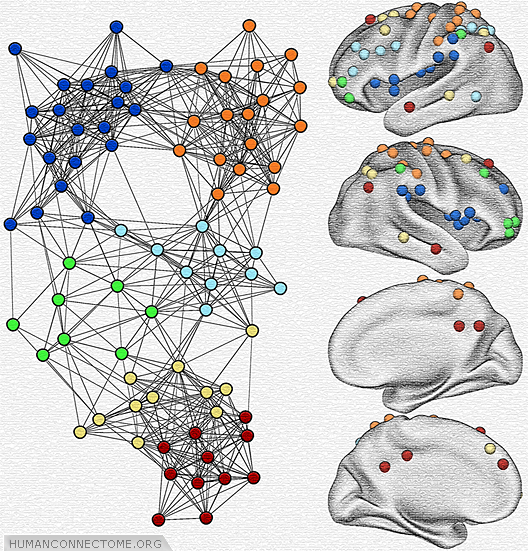- >>
- Healthy Adult Studies
- HCP Young Adult
- News
- Article
Visualizing the Networked Brain: A Parcellation Scheme for Human Left Lateral Parietal Cortex
This network image comes from the latest thesis work by Steve Nelson, working under the auspices of Steve Petersen, PhD, the James S McDonnell Professor of Cognitive Neuroscience at Washington University in Saint Louis. Nelson’s research is using fcMRI and fMRI to parcell the parietal cortex, yielding a fascinating diagram of function and structure.
The left half of the figure is a graphical layout of the functional correlations between regions. The different colors represent different subnetworks defined by modularity optimization. The right half plots the different subnetworks on the brain, showing how each subnetwork is distributed across the cortex.

Here is the abstract from the paper, which was published in Neuron, Volume 67 Issue 1 on July 15th, 2010.
The parietal lobe has long been viewed as a collection of architectonic and functional subdivisions. Though much parietal research has focused on mechanisms of visuospatial attention and control-related processes, more recent functional neuroimaging studies of memory retrieval have reported greater activity in left lateral parietal cortex (LLPC) when items are correctly identified as previously studied (“old”) versus unstudied (“new”). These studies have suggested functional divisions within LLPC that may provide distinct contributions toward recognition memory judgments. Here, we define regions within LLPC by developing a parcellation scheme that integrates data from resting-state functional connectivity MRI and functional MRI. This combined approach results in a 6-fold parcellation of LLPC based on the presence (or absence) of memory-retrieval-related activity, dissociations in the profile of task-evoked time courses, and membership in large-scale brain networks. This parcellation should serve as a roadmap for future investigations aimed at understanding LLPC function.
Neuron. 2010 Jul 15;67(1):156-70.